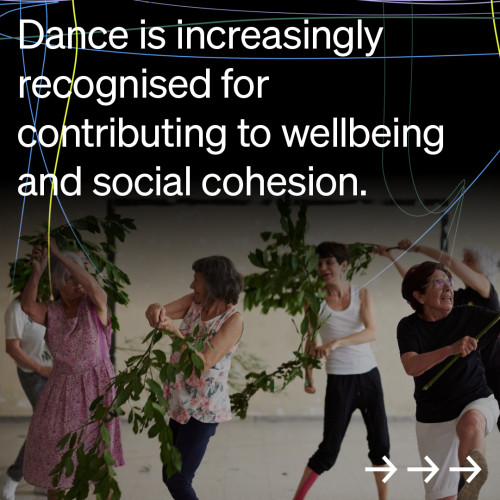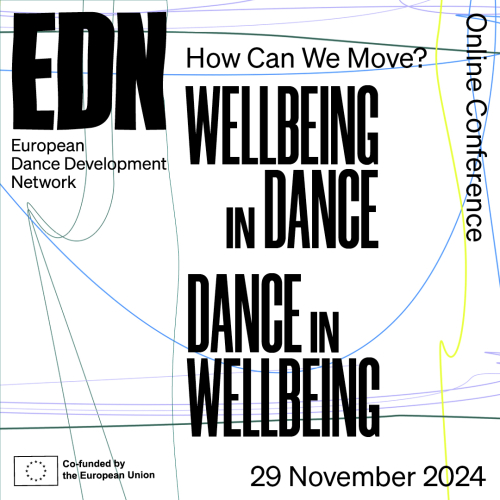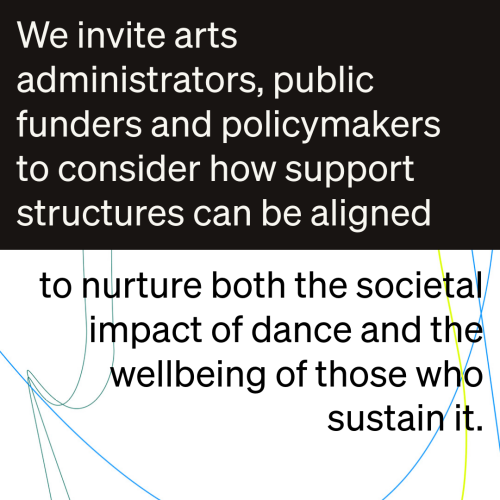Dance Platforms and Showcases
save the dates
International dance platforms and choreographic showcases in Europe you might not want to miss.
More
Calling for policy changes that recognize and support dance's contributions to societal development.
Dance is increasingly recognised for contributing to wellbeing, healing and social cohesion. How can we ensure that the value of dance extends to those who create and sustain it?
We invite arts administrators, public funders and policymakers to consider how support structures can be aligned to nurture both the societal impact of dance and the wellbeing of the artists and organizations progressing it.
Wellbeing in Dance
This campaign highlights the intersection of dance and wellbeing and calls for policy changes that recognize and support dance's contributions to societal development.
As the EU-funded network of dance development organisations, EDN advocates for improved working conditions for dance artists and other professionals, dedicated dance infrastructure, and sustainable funding mechanisms that rightfully reflect the public and societal value of the professional dance ecosystem.
Dance in Wellbeing
Dance is an expression of relational meaning, embodied in practices, movements, rituals and rhythms by which humans and other beings relate to one another. Contemporary dance culture is both a multifaceted artform and a professional practice that enhances societal wellbeing by way of embodiment, belonging, deepening and diversifying one’s sense of identity.
Dance professionals* work in inadequate conditions, with insufficient funding and a lack of sustainable infrastructure. These issues not only affect the wellbeing of dance professionals but also hinder the sector’s capacity to contribute to societal wellbeing on its own terms.
Dance requires specific conditions to thrive and to hold space for participatory experimentation. These conditions include sustainable funding, equitable working conditions, and dedicated infrastructure.
*Dance professionals here designate both artistic and administrative professionals, freelance, self-employed, employed and unemployed artists, and all other professionals working in the dance sector.
What is Wellbeing?
Wellbeing refers to the quality of life that allows individuals and communities to thrive with a sense of purpose, resilience, and the capacity to face challenges. It’s a holistic measure of societal health, including physical, mental, and social aspects.
What is Dance?
Dance is a performative art form and a cultural practice that embodies the transformations of societies today. It encompasses diverse fields, from education to professional practice, including research, artistic development, and community engagement.
Who is the Dance Sector?
The dance ecosystem includes a wide range of citizens, organisations, and institutions, from students, educators, and artists to presenters, administrators, funders, and audiences. Each group plays a critical role in the sector’s sustainability and contributes to its wellbeing. Together, they form a network of professionals and amateurs whose work and participation enhance the societal fabric.
Where do Dance and Wellbeing meet?
Dance fosters embodiment, builds community, and enhances the overall quality of life. Contemporary dance culture intersects with wellbeing in private and public settings, spaces for dance development and presentation, education, settings with children, youth, and teachers, people dealing with forced displacement, medical settings, intercultural and intergenerational settings, and contexts of trauma, conflict, and grief.
Dance artists and other professionals who have cultivated their artistic practices specifically for the needs of those contexts deserve recognition, research and visibility on their own terms.
Wellbeing in dance means ensuring fair working conditions for dance artists and other professionals, access to healthcare and social security, access to resources, and the sustainability of professional dance practices.
What do Dance and Wellbeing miss?
Recognition of Value
Despite its contributions to societal wellbeing, dance is often undervalued as an artistic, cultural, and professional practice, a public good and a public service.
Sustainable Working Conditions
Many dance professionals deal with precarious working conditions, including low wages, lack of job security, hindered mobility, nomadism, administrative barriers, and inadequate access to healthcare and social security.
Funding and Infrastructure
The dance sector is chronically underfunded and overworked. The existing funding mechanisms are fragmented, short-sighted, and do not address the sector’s needs, which leads to instability, unhealthy work environments, and unsustainable practices.
Our Policy Wishlist for Dance
1. Recognize the Role of Dance in Societal Wellbeing
Acknowledge the dance sector as a vital contributor to societal wellbeing in public policy.
2. Integrate Wellbeing into Policy Frameworks
Ensure that the dance sector is included in policies targeting working conditions, public services, and workforce wellbeing, prioritizing fair remuneration, social security, and access to healthcare regardless of employment status.
3. Invest in Sustainable Infrastructure
Investing in dedicated spaces for dance education, research, production, distribution, and development will support the long-term development of the dance sector.
4. Create Sustainable Funding Streams
Develop funding models that enable dance professionals to focus on artistic creation and community engagement without compromising financial stability.
5. Establish Dedicated Wellbeing Programs
Launch complementary initiatives that alleviate administrative burdens for professionals, allowing them to focus on impactful work within their communities.
6. Support Cross-Disciplinary Collaboration
Create funding mechanisms that encourage collaborations between cultural institutions, social partners, healthcare organizations, and educational institutions to create supportive environments for dance.
7. Fund Documentation and Research
Support data collection and research initiatives that complement artistic production.
Supporting the dance sector through improved working conditions, sustainable infrastructure, and appropriate funding mechanisms is essential for enhancing societal wellbeing. Policymakers must recognize and support the vital role that dance plays in fostering embodiment, creativity, self-expression, social cohesion, and belonging. By prioritizing the wellbeing of dance professionals, we can ensure that the sector continues to thrive and contribute to the wellbeing and sustainable development of communities today.
Where Do We Go From Here

Move beyond the given and collaborate with experts, social partners, educators, cultural institutions, healthcare organizations, and policymakers to collectively contribute to change.
Raise awareness and launch campaigns that communicate the value of dance, the meaning generated by dance work and the impact of contemporary dance practices to articulate and reveal what may be kept obvious to some and hidden to others.
Advocate and engage your local decision-makers by outlining the challenges and proposing solutions to influence policy at local, national, and regional levels.
Download the Advocacy Brief
Join the Conversation

Register for our online event of the year and engage with experts, artists, and changemakers working towards a more sustainable dance ecosystem.
Sharing is Caring

Stay Connected
Subscribe to our newsletter and stay informed about our network's latest activities, news from our members, and the dance sector in Europe.
About the Project
Each year, EDNext investigates important topics relevant to the contemporary dance sector and disseminates the findings. In 2024, the project facilitated a series of activities for the mapping of practices dedicated to care and wellbeing in contemporary dance. EDNext is brought to you with the support of the Creative Europe funding.